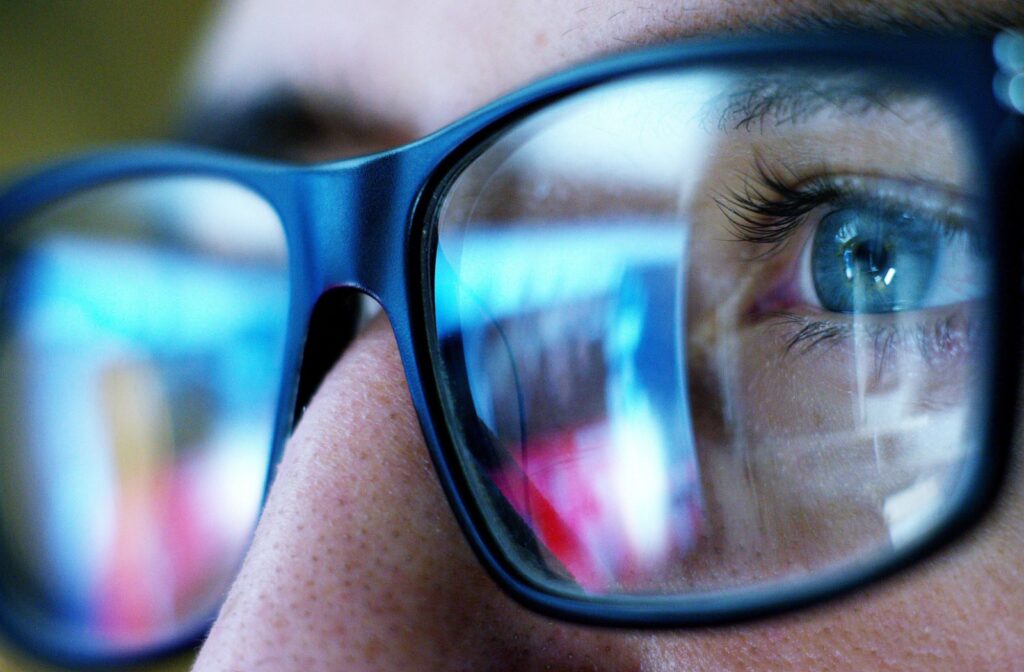As a student or faculty member, your day likely involves shifting focus between books, notes, and various digital screens. If you’ve noticed your eyes feel tired or your vision seems less sharp after these tasks, you’re not alone. The visual demands of campus life are unique, which is why keeping up with your eye health through regular eye exams is so important. This also brings up a common question about two popular types of eyewear.
While they both help with near-vision tasks, reading glasses and computer glasses are designed for different purposes and are not the same. Each is tailored for a specific distance to help you see clearly and comfortably, whether you’re looking at a textbook or a computer monitor.
What Are Reading Glasses?
Reading glasses help magnify text, making it clearer and easier to read. They’re designed for use at a close distance—typically about 14 to 16 inches away from your eyes.
These glasses primarily address a common, age-related vision change called presbyopia. Presbyopia is a natural process where the eye’s lens becomes less flexible, making it harder to focus on nearby objects.
Over-The-Counter vs. Prescription Reading Glasses
You can find simple reading glasses in many stores. These offer the same magnification power in both lenses and work well for some people. However, a pair of prescription reading glasses may provide clearer, more comfortable vision if you have different needs in each eye or have astigmatism.
What Are Computer Glasses?
Computer glasses are specifically made for viewing digital screens at an intermediate distance. Most people sit about 20 to 26 inches from their computer monitor, which is farther than reading distance but closer than driving distance. Computer glasses are tailored to provide clear vision at this specific interval.
How Computer Glasses Help Your Eyes
Working at a computer for hours can lead to digital eye strain. Computer glasses can help reduce this discomfort in several ways:
- They have a lens power optimized for your screen’s distance.
- They help your eye muscles relax, reducing fatigue.
- They can encourage better posture, so you don’t have to lean in or tilt your head.
- Many options include anti-glare coatings or light-filtering technology.
As optometrists in Austin, we can recommend the right set of features for your specific work setup and vision needs.
The Core Difference Is Distance
The main distinction between reading glasses and computer glasses is the distance they’re designed to be used at. Reading glasses are for close-up work, while computer glasses are for intermediate distances.
Why Readers May Not Work for Your Computer
Using reading glasses to view a computer screen can cause problems. Because their magnification effect is set for a closer distance, you might find yourself leaning forward or craning your neck to see clearly. This can lead to eye fatigue and discomfort in your neck and shoulders.
What About Other Screens Like a TV?
Watching television is typically a distance vision task. Neither reading glasses nor computer glasses are intended for this purpose. If you have trouble seeing your TV screen, it may relate to your distance vision rather than your near or intermediate vision.
Signs You Might Benefit From Task-Specific Glasses
You may find relief with glasses designed for a specific task if you regularly experience symptoms such as:
- Headaches after long periods of reading or screen use
- Eyes that feel tired, dry, or strained
- Blurry vision when you look away from your screen or book
- Neck & shoulder pain
- Trouble keeping small print in focus

How to Find the Right Eyewear Solution
Choosing the right glasses is a bit like choosing the right pair of shoes—what works for one activity may not be ideal for another. Your needs depend on your daily tasks, your workspace setup, and your individual vision. To find quality eyewear in Austin that fits your life, it’s helpful to talk with an eye care professional.
What to Discuss With Your Optometrist
A comprehensive eye exam is a great place to start. To get the most helpful recommendation, be prepared to talk about your routine:
- Your typical daily work—do you use multiple monitors or read a lot of printed materials?
- The distance between your eyes and your computer screen.
- The number of hours you spend on digital devices each day.
- Any specific symptoms or discomfort you feel.
A conversation with an optometrist in Austin can help you discover a clear and comfortable solution for all your daily activities.
At Eclectic Eyewear, we’re passionate about enhancing your vision and helping you express your personality. We’re here to support you and your family on your healthcare journey with professional and approachable care. From timeless and sophisticated to daring and adventurous—we’ve got eyewear that can truly reflect you. Ready to make your study sessions more comfortable and stylish? Schedule a visit with us today to find the perfect solution for your visual needs.


